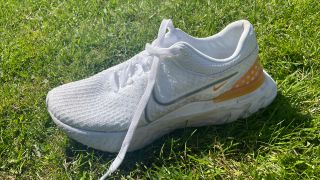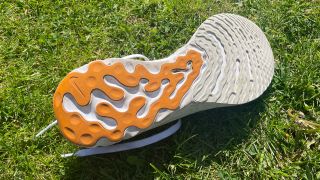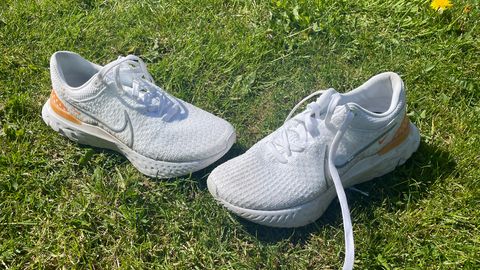Our Verdict
The Nike React Infinity Run Flyknit 3 offers a stable and protective ride that’s great for new runners or those logging a lot of miles of easy training. However, there are more versatile shoes around, and its price is off-putting when you can get better for less.
For
- Stable design
- Durable
- Smooth ride
Against
- Can find better value elsewhere
- Not the most exciting ride
- Similar to predecessor
You can trust Coach
The Nike Infinity Run line of shoes provides a cushioned ride without the instability that can arise with high stacks of foam underfoot. The shoe’s ride has not changed much in three generations, with the adjustments confined to the upper, which has become more supportive and cushioned each year. So, those hoping for a big change with the Infinity 3 will be disappointed, but those who enjoyed the Nike React Infinity Run Flyknit 2’s smooth ride and long-lasting design will find more of the same in the latest version. However, it’s pipped to our round-up of the best Nike running shoes by the Nike Pegasus 39, and you’ll find better cushioned models in our recommendations of the best running shoes.
Nike React Infinity Run Flyknit 3 Review: Price And Availability
The Infinity Run Flyknit 3 is available now and costs $160 in the US and £144.95 in the UK. In Nike’s cushioned shoe range it comes in cheaper than the Nike React Invincible, which is £165, but it’s more expensive than the Pegasus 39, which is £110.
It is available direct from Nike US and Nike UK, as well as retailers like Pro:Direct Running which provided the review samples.
Design And Fit

The main changes to the Infinity Run 3 compared with the 2 are found in the Flyknit upper, which now uses Nike’s Flywire system to create a more secure hold around the midfoot. There’s also more padding around the heel and ankle, which no doubt contributes to the slight increase in weight: the Infinity 3 is 310g in my UK 9 compared with 303g for the 2.
As with its predecessor, the Infinity 3 fits me well in my normal running shoe size and my heel didn’t slip at all. In truth, the upper changes weren’t that noticeable to me while running, aside from the fact the tongue seems more securely fastened with the new shoe – it was easy to tear it away from the upper on the Infinity 2.
The midsole seems the same on the new shoe as it was on the Infinity 1 and 2. There is a generous stack of React cushioning, which has a firm feel to it that’s softened by the rocker shape of the shoe, which helps you roll smoothly through your footstrike. It’s not a “squishy” shoe, which helps with stability – something also aided by the wide base and large plastic heel clip that runs around the back of the shoe.
Nike has not provided official stats on stack height and offset for the Infinity 3, but the 2 had a heel-to-toe drop of 9mm for men and 8.4mm for women, and I would assume something similar here.
The outsole has a generous covering of rubber in a splotchy pattern and, as with previous versions, I expect this to hold up to many miles of running. It grips well on wet pavements, too.

How I Tested This Shoe
I ran 50km in the Nike Infinity Run 3, mostly through easy runs with one slightly quicker effort at just under 4min/km pace. I’ve also logged two hundred kilometres in the past two versions of the shoe.

Running Performance
The Nike Infinity Run has always been a shoe I’ve reached for during intense periods of training when I want a cushioned but still stable ride for easy runs on tired legs. The third version is still a top option for that. You don’t get the same energetic squish and bounce of shoes such as the Nike Invincible or Asics Novablast, but the smooth ride is comfortable and reliable, and far more stable even if the Infinity is not a full stability running shoe.
You don’t get much feel for the ground in the shoe, which deadens the impact of running, and it’s not a great option for faster running, something that isn’t helped by the Infinity 3 adding weight in the upper. It can handle tempo runs OK, but lacks speed for interval workouts, which you would expect from a cushioned shoe mainly designed for easy runs.
I didn’t notice the changes to the upper on the run myself, and if you are familiar with the Infinity line already then you will get more of the same from the 3.
Is The Nike React Infinity Run Flyknit 3 Worth It?
The Infinity Run 3 is built to protect the body on the run and help you rack up miles in comfort without sacrificing stability. It does that job well. It’s not the most versatile of shoes, or the most exciting, but beginners looking for a stable neutral shoe or experienced runners looking to round out a rotation with a reliable option for logging easy runs will find it here.
It’s expensive, however, and you will find better value elsewhere. I’d start by looking for deals on the Infinity 2, which offers a similar experience, and within Nike’s range there is also the Pegasus 39 for £110, which is lighter and more versatile while still being comfortable on easy runs.
Outside of Nike’s range you’ll find excellent daily trainers like the Puma Velocity Nitro 2 and Reebok Floatride Energy 4 for £100 or under, and there’s also the Saucony Ride 15 for £130. All three shoes are lighter and more versatile than the Infinity 3, and the Puma in particular has a more enjoyable, bouncy ride, though it isn’t as stable as the Nike.

Nick Harris-Fry is a journalist who has been covering health and fitness since 2015. Nick is an avid runner, covering 70-110km a week, which gives him ample opportunity to test a wide range of running shoes and running gear. He is also the chief tester for fitness trackers and running watches, treadmills and exercise bikes, and workout headphones.

